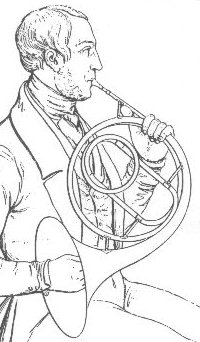The transition era from the natural horn to the valved horn is a fascinating one. Perhaps the clearest way to understand the basic issues at work is to focus on the natural horn writing of three major composers in this transition era, Beethoven (whose Sonata was just briefly examined in the previous installment of the University of Horn Matters series), Schubert, and Brahms.
Before looking at our three composers of the day there is first a question of aesthetics to consider. Dauprat in his Method (published in 1824, a massive publication) gets at the idea that shifts of tonal color from open notes to stopped notes was to be desired and gave important shades and nuances to the sound of the horn. His comments may be read in the brief article linked below in Horn Articles Online:
Long articles specifically related to Beethoven, Schubert, and Brahms are also to be found in Horn Articles Online and will be considered to be required reading for those following the University of Horn Matters series in full.
- E. C. Lewy and Beethoven’s Symphony No. 9
- Schubert and the Lewy Brothers
- Brahms and the Orchestral Horn [Note: This is a new article, just posted last week to Horn Articles Online]

In all three of these articles there is a bigger picture to see, and that is that there is an older literature on horn history that says some sketchy things on all three of these composers that modern students of horn history need to keep clear. In short they would be:
- Beethoven 9 is rumored to have been for valved horn but that is not the case, it is natural horn writing
- Schubert did not compose Auf dem Strom for valved horn; it is natural horn writing even if the first player to perfom it was a valved horn pioneer
- Brahms wrote all his horn parts for natural horn, there is no indication at all that he was thinking of sections split between natural and valved horns in any way.
As to major natural horn players and teachers of the time, in terms of today certainly the best known is Jacques-François Gallay (1795-1864), as several volumes of his etudes have become standards. This image is from his Method. For an introduction to Gallay and one of his best known publications please read:
The nineteenth century was a transition era; it took us from the natural horn with no valves to the double horn. We will have more on that era in the next installment of the University of Horn Matters.
Buying or selling something?
Check out Horn Matters Classified Ads!
Please visit our advertising sponsors:
Related articles:
- University of Horn Matters: The Horn in the Classical Period By the end of the eighteenth century two primary types of natural horns were found in general use, the most...
- Brahms and Modern Performance on the Natural Horn Brahms wrote for the natural horn in all of his works but wrote for it in a period when the...
- Dvorak on the Natural Horn? Julia Rose in a very recent post on a classical concert she performed with the Columbus Symhony brought up the...
- University of Horn Matters: Who Invented Hand Horn Technique, and the Early Classical Horn To continue this series we today have what is likely to be one of the longer articles posted, as it...
- Auf dem Strom and the Natural Horn People by nature try to categorize things and find notable “firsts.” One “first” often given to Schubert, incorrectly, is that...
- University of Horn Matters: The Horn Before 1750 With this article we begin a regular feature on Horn Matters, a series under the heading University of Horn Matters....
- Dukas Villanelle and the Natural Horn The first of two posts on performing Dukas Villanelle, posted on 9/18/05 in the original Horn Notes Blog Villanelle by...